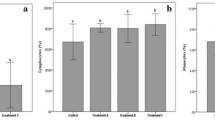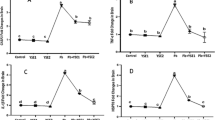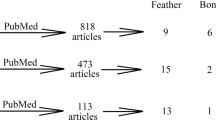Abstract
Common tern,Sterna hirundo, chicks injected with lead (Pb) nitrate (IP) showed slower weight gain than controls, due to reduced assimilation efficiency, rather than reduced food intake. The ability to manipulate fish, involving complex motor coordination of head and neck, showed impairment, while the ability to locate and seize fish did not. The study demonstrates that Pb can selectively impair certain behavioral functions of feeding.
Similar content being viewed by others
References
Burger J, Gochfeld M (1985) Early postnatal lead exposure: behavioral effects in Common Tern chicks (Sterna hirundo) J Toxicol Environ Health 16:869–886
Burger J, Lesser F (1978) Breeding behavior and success in salt marsh Common Tern colonies. Bird-Band 50:322–337
Cain BW, Pafford EA (1981) Effects of dietary nickel on survival and growth of mallard ducklings. Arch Environ Contam Toxicol 10:737–745
Connors PG, Anderlini VC, Risebrough RW, Gilbertson M, Hays H (1975) Investigations of heavy metals in Common Tern populations. Canadian Field Nat 89:157–162
Cory-Slechta DA, Weiss B, Cox C (1983) Delayed behavioral toxicity of lead with increasing exposure concentration. Toxicol Appl Pharm 71:342–352
Cutshall NH, Naidu JR, Pearcy WG (1978) Mercury concentrations in Pacific Hake,Merluccius productus (Ayres), as a function of length and latitude. Science 200:1489–1491
DeValut DS (1985) Contaminants in fish from Great Lakes harbors and tributary mouths. Arch Environ Contam Toxicol 14:587–594
Dieter MP, Finley MT (1979) Delta-aminolevulinic acid dehydratase enzyme activity in blood, brain and liver of lead-dosed ducks. Environ Res 19:127–135
Donaldson WE, Leeming TK (1984) Dietary lead: Effects on hepatic fatty acid composition in chicks. Toxicol Appl Pharm 73:119–123
Gochfeld M (1975) Hazards of tail-first fish swallowing. Condor 77:345–346
— (1980) Learning to eat by young Common Terns: Consistency of presentation as an early cue. Proc Colonial Waterbirds 3:108–118
Gochfeld M, Burger J (1982) Biological concentration of cadmium in estuarine birds of the New York Bight. Colonial Waterbirds 5:116–123
— (1987) Factors affecting tissue distribution of heavy metals; age effect in Common Terns,Sterna hirundo. Biol Trace Metal Res 12:389–399
Golter M, Michaelson IA (1975) Growth, behavior, and brain catecholamines in lead-exposed neonatal rats: A reappraisal. Science 187:359–361
Howarth DM, Hulbert AJ, Horning D (1981) A comparative study of heavy metal accumulation in tissues of the Crested Tern,Sterna bergii, breeding near industrialized and non-industrialized areas. Austral Wildlf Res 8:665–672
Hutton M (1981) Accumulation of heavy metals and selenium in three seabird species from the United Kingdom. Environ Pollut 26A:129–145
Katti SR, Sathyanesan AG (1983) Lead nitrate induced changes in lipid and cholesterol levels in the freshwater fishClarias batrachus. Toxicology Letters 19:93–96
Kendall RJ, Scanlon PF (1979) Lead concentrations in mourning doves collected from middle Atlantic game management areas. Proc Ann Conf SE Assoc Fish Wldlf Agencies 33:165–172
Lorton D, Anderson WJ (1986) The effects of postnatal lead toxicity on the development of cerebellum in rats. Neurobehav Toxicol Teratol 8:51–59
Maedgen JL, Hacker CS, Schroder GD, Weir FW (1982) Bioaccumulation of lead and cadium in the Royal Tern and Sandwich Tern. Arch Environ Contam Toxicol 11:99–102
Marples G, Marples A (1934) Sea Terns or Sea Swallow, London, Country Life Ltd
Mobarak N, P'an AYS (1984) Lead distribution in the saliva and blood fractions of rats after intraperitoneal injections. Toxicol 32:67–74
Needleman HL, Gunnoe C, Leviton A, Reed R, Peresie H, Maher C, Barrett P (1979) Deficits in psychologic and classroom performance of children with elevated dentine lead levels. New Engl J Med 300:689–695
Palmer RS (1941) A behavior study of the common tern (Sterna hirundo hirundo L). Proc Boston Soc Nat Hist 42:1–119
Phillips GR, Lenhart TE, Gregory RW (1980) Relation between trophic position and mercury accumulation among fishes from the Tongue River Reservoir, Montana. Environ Res 22:73–80
Rice DC (1984) Behavioral deficit (delayed matching to sample) in monkeys exposed from birth to low levels of lead. Toxicol Appl Pharmacol 75:337–345
Rohrer TK, Forney JC, Hartig JH (1982) Organochlorine and heavy metal residues in standard fillets of coho and chinook salmon of the Great Lakes—1980. J Great Lakes Research 8:623–634
S.A.S. Institute, Inc. (1985) Basics: Statistics. Statistical Analysis System Institute, Cary, NC
Van der Molen EJ, Blok AA, de Graaf GJ (1982) Winter starvation and mercury intoxication in Grey Herons (Ardea cinerea) in the Netherlands. Ardea 70:173–184
Weiss B (1982) Behavior as a sentry of metal toxicity. In: Di Ferrante E (ed) Trace Metals: Exposure and Health Effects. Pergamon Press, New York, pp 185–192
Author information
Authors and Affiliations
Rights and permissions
About this article
Cite this article
Gochfeid, M., Burger, J. Effects of lead on growth and feeding behavior of young common terns (Sterna hirundo). Arch. Environ. Contam. Toxicol. 17, 513–517 (1988). https://doi.org/10.1007/BF01055517
Received:
Revised:
Issue Date:
DOI: https://doi.org/10.1007/BF01055517




